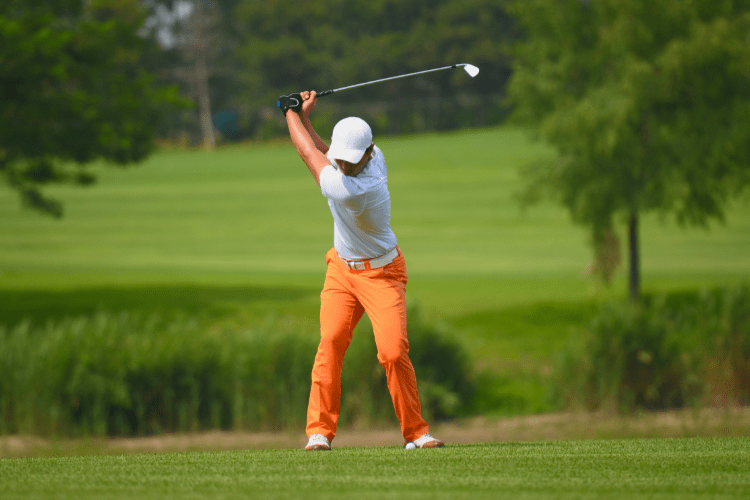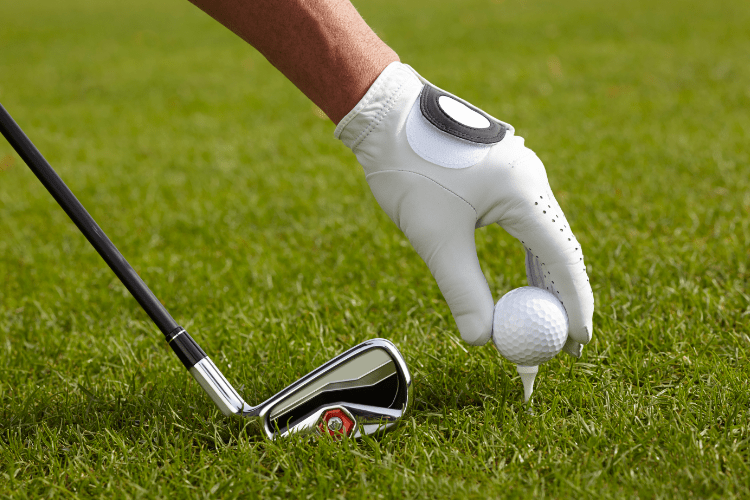How to Increase Club Head Speed
Posted by

Some golfers make it look effortless, generating incredible speed without seeming to try. If you’ve ever wondered how they do it, the answer isn’t just raw power—it’s a combination of technique, flexibility, and efficiency.
Club head speed plays a huge role in the distance, and improving it doesn’t mean swinging harder. Taking golf lessons to make adjustments to your mechanics, grip, and body movement can lead to big gains while keeping your golf shots controlled. The key is finding what works for you.
Club Head Speed 101
A lot of golfers assume that more muscle equals more distance, but that’s only part of the equation.
Timing, technique, and stance all play a huge role in generating club head speed—the speed of your club just before impact—which directly affects how far the ball travels.
Some players hold back, worried that swinging faster will wreck their accuracy, but a balanced stance and smooth tempo help keep shots on target.
One of the biggest keys to adding speed is the transition from backswing to downswing. Rushing this move creates tension, which actually slows you down.
The best way to build more ball speed is by focusing on solid fundamentals. A stable stance, engaged core, and relaxed arms all work together to create effortless power.
Think of sweeping through the ball instead of forcing the swing—this mental shift helps loosen up your shoulders and encourages better flow.
Patience is key here. Trying to swing faster overnight can throw off your rhythm, leading to more mishits than extra yards.
Instead, gradually increasing speed while maintaining control leads to real, lasting improvements. As your mechanics become second nature, confidence grows, and those extra yards start to come naturally.
The Role of Physical Fitness in Increasing Club Head Speed

A powerful, fluid swing isn’t just about technique—it also comes down to how well your body moves. Golf might not seem as physically demanding as other sports, but generating speed takes a mix of strength, flexibility, and stability.
Your legs and core provide the foundation for power, while flexible joints allow for a full, tension-free turn. A well-rounded approach that includes both strength training and mobility work can help you increase swing speed without feeling like you’re forcing it.
The good news? You don’t need a gym membership or hours of training to see results. Even a few minutes of targeted exercises at home can help your body move more efficiently and add natural speed to your swing.
Building a Strong Foundation
Before focusing on speed, it’s important to build a solid foundation. Good posture, balance, and core stability all contribute to a smoother, more controlled swing.
Simple exercises like single-leg stands, resistance band work, and bodyweight squats can improve your balance and help your body work as a cohesive unit.
A strong foundation allows for better weight transfer and control, preventing the kind of instability that can slow your swing down.
Strength Training for Golfers
Building strength doesn’t mean bulking up—it’s about developing the muscle groups that support a powerful yet controlled swing.
Exercises like squats, lunges, and planks create a stable base, while moves like medicine ball twists or cable rotations train your torso to rotate with force. The key is focusing on proper form and gradually increasing resistance rather than maxing out lifts.
Stronger legs and core muscles make it easier to generate rotational power, leading to faster, more consistent swings.
Flexibility and Mobility Exercises
More flexibility means less effort—and often, more speed. Dynamic warm-ups like shoulder rolls and hip rotations loosen up key joints, while yoga-style stretches or simple rotational drills improve range of motion.
The goal is to move freely without tension so your swing flows naturally instead of feeling restricted. Consistently working on hip, shoulder, and spine mobility can help you turn more efficiently, adding effortless speed to your game.
Improving Your Swing Technique

Even the best clubs won’t fix a flawed swing. To maximize speed and power, you need to focus on the basics—grip, stance, and overall movement.
Many golfers find that recording their swing from different angles helps them spot small issues that could be holding them back. Even a minor tweak, like adjusting your backswing path or grip pressure, can make a huge difference in how fast and efficiently you move the club.
But here’s the key: it’s not just about swinging harder. The real secret to speed is a smooth, well-sequenced motion. Rushing or forcing it often does more harm than good.
The goal is to create effortless power by finding the right balance between control and relaxation. Once you dial in the fundamentals, adding speed becomes much easier.
If you’re looking for expert advice, Skillest can help you take your swing to the next level. You can send your swing videos to top golf instructors who’ll provide personalized feedback, helping you refine your technique and unlock more power.
Perfecting Your Grip and Stance
Your grip and stance set the foundation for everything that follows.
Grip the club too tightly, and you’ll restrict your wrist action, making it harder to generate speed. Hold it too loosely, and you risk losing control at impact. A firm but relaxed grip—think of holding a tube of toothpaste without squeezing any out—is the sweet spot.
Your stance also plays a big role. Stand with your feet about shoulder-width apart, knees slightly bent, and weight evenly distributed between your heels and toes.
Tilting forward from the hips (rather than hunching your back) keeps your spine aligned, allowing for a full, unrestricted turn.
Engaging Your Whole Body for More Power
Powerful swings don’t come from just the arms—they come from the entire body working together.
The hips start the movement, passing energy to the torso, shoulders, and finall, the arms and club. If your lower body isn’t engaged, your arms will have to work twice as hard, limiting speed and consistency.
A smooth weight shift from your back foot to your front foot is key. If you find yourself swaying or feeling off-balance, try practicing slow, controlled swings to ingrain the proper sequence.
Over time, this full-body coordination will help you unlock more effortless speed and distance without feeling like you’re forcing it.
Practicing with Purpose

Hitting ball after ball at the range might feel productive, but if you’re not practicing with a plan, you might just be reinforcing bad habits. The key is to make every swing count.
Instead of just hoping for improvement, set a clear goal for each session—whether it’s refining technique, increasing golf swing speed, or improving accuracy.
Tracking your progress can also make a huge difference. A simple notebook or a notes app on your phone can help you spot trends in your swing and measure what’s working.
And if you want even more targeted feedback, platforms like Skillest can help woth speed training by allowing you to share swing videos with coaches who can guide you in real time. Getting that kind of expert insight can help you avoid common mistakes and speed up your progress.
Incorporating Speed Drills
Speed drills are a great way to train your body to swing faster. One of the most effective methods is using a weighted club or training stick—swinging something heavier than your regular club helps build strength, and when you switch back to your normal club, it’ll feel much lighter and easier to move quickly.
Another popular drill involves stepping forward as you swing, which helps create momentum and improve weight transfer. But here’s the trick: start slow. Rushing into max-speed swings without control can lead to sloppy form.
Instead, focus on balance first, then gradually pick up the pace. Short bursts of high-intensity swings can push your speed limits, but don’t overdo it—rest and recovery are just as important to avoid fatigue and keep progress steady.
Staying Consistent
Improving swing speed doesn’t happen overnight, but steady, focused practice will get you there.
Instead of cramming everything into one long-range session, break it up into shorter, more intentional practices a few times a week. A 30-minute session with a clear focus will do more for your game than hours of aimless hitting.
Tracking your swing speed, ball flight, or even how each shot feels can help you see what’s working and what needs tweaking. Over time, this kind of mindful practice creates lasting improvements—not just in speed but in overall control and consistency.
Stick with it, and you’ll start seeing results where it really matters: on the course.
Boosting Your Mental Game

The mental side of golf plays a huge role in how fast you can swing the club—and everything else. Stress, tension, and negative thoughts can hold you back, while a clear and positive mindset can unlock your potential.
Here are some simple strategies to help you stay focused, confident, and relaxed, leading to more speed in your swing:
Relax Your Mind to Free Your Swing
- Stress and tension can slow down your swing, especially in your shoulders.
- A calm mindset allows your arms to unwind freely, boosting speed.
- Focus on the target instead of worrying about hazards or past mistakes for a more confident rhythm.
Build Confidence with Preparation
- Confidence comes from honest practice and setting realistic expectations.
- Establish small routines (e.g., slow breaths, checking the target) to keep your mind grounded.
- Replaying a successful shot in your mind can boost optimism.
- Let go of mistakes quickly—carry that confidence and steadiness to the next shot.
Visualization Techniques for Success
- Picture a perfect shot in your mind: visualize the ball’s path or feel the hip rotation.
- Pair this mental imagery with practice swings to train your body.
- Take a brief moment of visualization before your shot to calm your nerves and focus.
- Over time, this builds confidence and flow, helping you swing faster without forcing it.
Using Tech and Tools

Technology makes it easier than ever to analyze your swing. Tools like launch monitors track swing speed, launch angle, and spin rate, helping you identify areas to improve.
Replays from different angles can also reveal habits like sliding hips or releasing the club early.
While data alone won’t solve everything, it provides clear focus and allows you to track progress, boosting confidence and motivation as you see steady gains.
Using Apps to Analyze Your Swing
Apps—if you find the right ones—can be a game-changer for golfers.
With certain platforms, you can record your swing and slow it down to break down every move. This visual feedback is great for spotting things like posture problems or an open club face at impact.
Remote coaching, with apps like Skillest, can be another lifesaver. Top golf instructors can analyze your swing and provide personalized tips. Online golf lessons can highlight angles to guide your improvement, making it feel like you have an expert in your pocket.
Regularly checking your swings with these apps can help you catch small issues before they turn into bigger problems. Pairing these insights with solid practice ensures you’re moving in the right direction.
Choosing the Right Equipment
Using gear that matches your swing can also uncover some hidden speed. For example, a driver with the right shaft flex can help you generate more distance by letting the golf club whip through impact.
If your driver is too stiff, you’re wasting energy. If it’s too flexible, you lose control. A fitting session at a local store or range can help you find the best options.
Even your golf ball makes a difference! Certain balls compress differently, so finding the right one can help you get the most out of every type of golf shot.
Matching your equipment to your style and physical ability makes it easier to gain speed without overexerting yourself.
Common Mistakes to Avoid

When you’re working on increasing clubhead speed, it’s easy to fall into a few common traps. Avoiding these mistakes will help you stay on track and make progress without frustrating setbacks.
Here are the key things to watch out for:
- Muscling the Ball: Trying to force more speed by muscling the ball from the top can create tension in your arms and shoulders, which actually slows the club down.
- Skipping the Warm-Up: Cold muscles and stiff joints don’t respond well to fast movements. A few light stretches or easy swings can help avoid strains and get your body ready for action.
- Focusing Too Much on Strength: While strength is important, it’s the flow of your swing that generates real acceleration. Trying to force power can lead to jerkier, less consistent swings.
- Neglecting the Short Game: While driving the ball long is fun, a lack of touch around the greens can spoil your round. Don’t overlook your short game in favor of just hitting bombs off the tee.
- Buying New Gear Instead of Fixing Technique: New clubs might help in some areas, but improving your technique is what really drives speed. Don’t rely on equipment to fix fundamental flaws in your swing.
- Changing Too Many Things at Once: Trying to fix everything at once can cause confusion and stall progress. It’s more effective to focus on one change, let it settle, and then move on to the next.
- Not Tracking Progress: If you’re not tracking your progress, you won’t know if a tweak is helping or hurting your swing. Keep track of improvements to see what’s working.
Building Speed With Consistency and Confidence

Increasing your club head speed is a journey that blends fitness, technique, and mental focus. Sure, muscle helps at first, but it’s really about efficiently transferring energy through your body to drive the ball farther.
Skillest connects you with expert coaches who tailor lessons to your specific needs, helping you improve quickly from home. By setting goals, tracking your progress, and working toward a relaxed, powerful swing, you’ll start seeing results.
The best part? Every improvement makes the game more enjoyable, turning each drive into a thrilling moment to watch your ball soar.
Frequently Asked Questions (FAQ):
What exercises increase club head speed?
Exercises that focus on your core, legs, and shoulders are key to boosting speed at impact. Squats, lunges, and rotational lifts build lower-body strength, while medicine ball throws or band pulls help improve the twisting motion that powers your swing.
What creates club head speed?
Club head speed comes from a coordinated series of movements starting from the ground up. Strong legs, a stable core, and fluid arm movements all work together during your body’s rotation.
A balanced grip and proper stance help channel energy from your lower body into the club head.
How to swing 120 mph?
Reaching a 120 mph club head speed requires consistent practice, solid fitness, and finely tuned mechanics. Many players use speed-focused drills or seek professional coaching to refine their motion.
Strengthening core golf muscles (like your legs and core) and improving timing can help push your swing toward that 120 mph mark.
Is 100 mph club head speed good?
A 100 mph club head speed is a great target for amateur golfers, usually providing a decent distance off the tee. For many, it’s a stepping stone to even more speed as they continue to refine their technique and timing.
